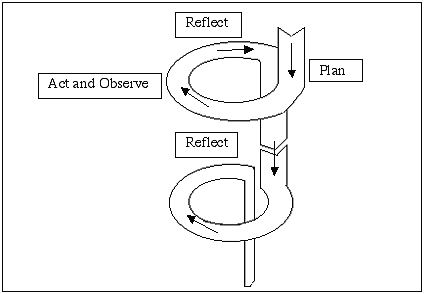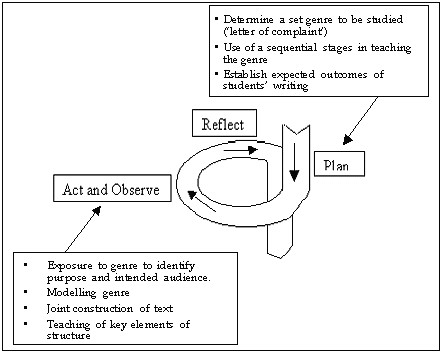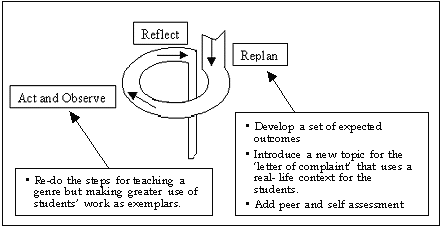
 |
This paper is concerned with finding an effective means for classroom teachers to reflect upon their current practice and take the necessary actions to improve that practice. The goal was to improve student performance in the Writing strand of the English syllabus. With the assistance of a facilitator, the teacher used action research to embark on a journey that involved posing problems and seeking solutions through action, reflection, discourse and revised action.
Action research provides a medium by which an issue may be addressed in an educational setting using a collaborative approach. It involves self-reflective enquiry by the participants in the process. As Kemmis and McTaggart (1988) suggest, it is undertaken to improve the rationality and justice of the participants' own social or educational practices. It is also engaged in order to understand these practices and the situations in which they are carried out.
For action research to be effective, it must not only be collaborative. It must also involve critically examined action by individuals involved in the process. Wadsworth (1991) describes this process as being one where action is intentionally researched and modified, leading to the next stage of action which is then again intentionally examined for further change, and so on.
The steps in an action research project are frequently described as cyclical or following a spiral of action. McKernan (1996) draws upon the work of researchers in the field of action research methodology to establish cycles of action where each loop consisted of four stages. These are described as the general plan, the action implemented, the action observed and the reflective critical evaluational element necessary to revise the plan or problem.
According to Winter (1996), action research can be summarised as a way to investigate professional experience by linking practice and the analysis of practice into a single productive and continuously developed sequence. Its strengths lie in the link between practice and reflection whereby new thoughts may be developed about familiar experiences. It also provides the opportunity to test particular practices and experiences against general ideas.
The action research project which is the focus of this study developed from a conversation between a Year 6 class teacher and her principal (the author). The teacher initiated this conversation, as she was concerned about the general standard of written expression in her class. She expressed concern as to the manner in which improvement in the students' performance might be achieved.
Subsequently, the principal suggested that an evaluation of the students' writing through the action research method might be useful if a means for generating improvement was being sought. Grundy and Kemmis (1981) had seen improvement as one of the two essential aims of all action research (the other being involvement). On improvement, they wrote (p. 88):
Action research aims at improvement in three areas:As the class teacher was unfamiliar with the action research methodology, the principal offered to undertake the role of facilitator. It was important that the principal and the teacher clearly understand their separate roles. According to Grundy (1994, p. 34), 'the teacher must be the researcher of that interactive process'. On the other hand, Grundy (1982) described the facilitator's work as: 'The facilitator could be regarded as a research engineer or technician'.
- the improvement of a practice,
- the improvement (or professional development) of the understanding of the practice by its practitioners, and
- the improvement of the situation in which the practice takes place.
In other words, the facilitator would provide the theory of action research and in so doing enlighten the researcher on the procedures involved with the process. However, as facilitators are usually viewed as possessing greater expertise, the principal needed to ensure that the researcher established and maintained control over the process.
In the proposed study, the facilitator's position as school principal had the potential to inhibit the development of the researcher's critical-reflective ownership of the process and the results. This was discussed before any action was undertaken. The facilitator sought agreement from the researcher as to the description of his role. In this, he used the definition provided by Grundy and Kemmis (1981): '... the changing role of the facilitator - from leader to support or resource person to group member or withdrawal'. It was resolved that this issue was to be an item for regular discussion at meetings between them.
It was agreed to create a 'table of invention' (Kemmis & McTaggart, 1988) to help organise the researcher's thoughts about the topic. This approach drew upon the work of Schwab (1969) whose views Grundy (1994, p. 30) describes as a dynamic perception of curriculum. In this approach, there were 'four commonplaces of schooling' - teachers, students, subject-matter and milieu. It is the interaction among these elements that gave dynamism to an educational institution. The points on which we agree are shown in Table 1.
From this analysis, it was resolved that strategies to improve the performance levels of the students would involve certain issues. These included:
| (A) Teachers | (B) Students | (C) Subject Matter | (D) Milieu | |
| (1) Teachers | There is a wide disparity of views among teachers on the elements of quality writing. | The students need clear expectations to be set by the teacher. | This subject matter of standards in writing should be a topic for a professional development day. | The school is a busy place, often resulting in teachers not having time to plan well. |
| (2) Students | The teacher believes the students are capable of better standards. | Most students in the classroom would not be aware of other students' writing. | If the students wrote from real-life experiences, it would be more relevant. | The milieu contains many conflicting elements that impact on students' time, namely sport and music. |
| (3) Subject Matter | The teacher believes that part of the problem is her lack of knowledge about teaching genres. | Students need to understand the purpose and the intended audience when writing. | The subject matter needs to be understand-able for the age of the students. | Resources for teaching written expression in this school are sparse. |
| (4) Milieux | The teacher finds the curriculum crowded and there are too many interruptions. | There is a wide range of student abilities in the classroom. | The students are largely from rural backgrounds. The school needs to recognise this and plan appropriate activities. | The environment of the school needs to give greater recognition to achievement and effort in students' writing. |

Figure 1: Action Research Cycle
(source McTaggart et al., 1982)
It was further agreed that there would be regular meetings between the researcher and the facilitator. These would occur at least once each cycle, mostly likely at the stage of reflection-upon-action. As Grundy and Kemmis (1981) say: 'The facilitator's principal sphere is the "moment" of reconstructive discourse in the action research cycle, that is, the process of reflection.'

Figure 2: First Cycle of the Action Research project.
When it came time to reflect upon the actions that had occurred in the cycle, the researcher made the following comments.
The actual improvement in the students' writing performance was not easily ascertained owing to a lack of indicators of performance. The researcher was still in the process of composing the set of outcomes that she expected students to attain. Possibly, it was too early in to expect sizeable gains. Kemmis and McTaggart (1988) comment on this by saying:
... you should remember that the situation, as it was before you introduced the changes, was structured on a set of premises which are different from the ones you have worked on.A revised plan was developed. On this occasion, the facilitator found himself needing to make fewer contributions. The researcher believed that written outcomes, composed by her, were important in the process and that they should form part of the second cycle. The second stage evolved in the manner shown in Figure 3.

Figure 3: Second Cycle of the Action Research Project.
When it came time for reflection upon the second cycle, the researcher commented that the students were responding well to her revised, and more structured, approach to teaching a written genre. She said that she based her views on:
The researcher believed that, through review of her practices and the inclusion of new techniques, her performance had improved. She said that she now saw the value of providing 'scaffolding' for students. Nearly all the students were able to use the structure to produce credible pieces of writing.
She was of the opinion that assessment techniques involving self-appraisal, peer assessment and one-on-one assessment (teacher/student) had been effective in helping to raise the standard of the students' work. In part, this had occurred through children working collaboratively, thereby sharing their written work to make improvements.
The researcher also believed it was a result of clear expectations being in place. She had developed a set of guidelines under the following headings: relevance to audience; generic structure; cohesion; use of vocabulary; spelling and grammar; and presentation. Beneath each heading were several pointers to performance. Students, appraising their own work, utilised a sheet that provided this framework in order to score their written work.
At this stage, the researcher said that she saw the improvements as being a consequence of thinking critically about the processes that had been occurring in the classroom. As Kemmis and McTaggart (1988) say, 'Action research is an approach to improving education by changing it and learning from the consequences of changes'.
New methodologies had been deployed to endeavour to effect a changed result. In so doing, the teacher had discovered for herself the benefits of setting clear goals. She had deployed a range of teaching strategies such as modelling and joint construction of text. She had also engaged in a range of assessment techniques that permitted the students to take greater responsibility not only for their own learning but also for the learning of others.
It is likely that you haven't mastered the skills necessary to do the things you hoped for. It will take a little time before you are as good at doing the new things as you were at the things you used to do.In many ways, it was the positive response by the students to her initiatives that gave confidence to the researcher. Her self-criticism shifted from negative thoughts to the position of saying: 'this is working. What other issues do I need to address to get better writing?'
During the project, there was always the danger that, because the facilitator was the principal, his roles could become blurred. Even if he was careful to avoid assuming any position of authority, the researcher could nevertheless view him as someone who was directing the process by casting himself as the expert and expecting his instructions to be carried out.
Grundy and Kemmis (1981) provide a number of tasks for facilitators. They are providing access to appropriate theory, ensuring easy communication, developing the process, ensuring equal distribution of power, practically assisting in the organisation for action and reflection, assisting in the process of reflection and making arrangements for the dissemination of results.
In this project, the facilitator endeavoured to remain within these bounds. Frequent checks were made with the researcher as to whether the protocols were being observed, as it was critically important that there be no hint of an 'expert/novice' approach. After all, the class teacher was the person posing problems. In this respect, Kemmis and McTaggart (1988) comment:
Action research involves problem-posing, not just problem- solving. It does not start from a view of problems as 'pathologies'. It is motivated by a quest to improve and understand the world by changing it and learning how to improve it from the effects of the changes made.In reviewing the project, the facilitator asked the researcher a number of questions. The first was related to the gains, which may have come from the process. Four responses were offered:
The facilitator asked the researcher to identify the disappointments. There appeared to be only one item in this regard. It related to some students still not fully grasping all concepts pertaining to the 'letter of complaint'. This had caused the researcher to continue to question the effectiveness of the methods she had deployed.
In response, the facilitator deployed the Socratic role, used in the 'moments' of reflective discourse during the project. Carr and Kemmis (1986) refer to this role as being 'to provide a sounding-board against which practitioners may try out ideas and as well as learning more about the process of self-reflection'. For the facilitator, it was a very positive sign that, despite the conclusion of the project, the researcher was still being reflective in order not only to seek explanation for some students' poor performance but also to find ways to remedy their problems.
Finally, the researcher was asked whether she would recommend action research to colleagues as a methodology for improvement. Her reply was in the affirmative and, to explain this viewpoint, she provided three reasons:
Grundy, S. L. 1982. Three modes of action research. Curriculum Perspectives, 2(3), pp. 23-34.
Grundy, S. L. 1994. The Curriculum and Teaching. In E. Hatton (Ed.) Understanding Teaching, pp. 27-33. Sydney: Harcourt Books.
Grundy, S. L. and Kemmis, S. 1981. Educational action research in Australia: The state of the art. Paper presented at the Annual Conference of the Australian Association for Research in Education, Adelaide. In Kemmis, S. and McTaggart, R. (1988). The action research planner.
Kemmis, S. & McTaggart, R. 1988. The action research planner. Geelong: Deakin University Press.
McKernan, J. L. 1996. Action research: historical and philosophical background. In A handbook of methods and resources for the reflective practitioner, pp. 3-34. London: Kogan Page.
McTaggart, R. et al. 1982. The action research planner (rev. ed.). Geelong: Deakin University Press.
Schwab, J. 1969. College curricula and student protest. Chicago: University of Chicago Press.
Wadsworth, Y. 1991. Everyday evaluation on the run. Melbourne: Action Research Issues Association Inc.
Winter, R. 1996. Some principles and procedures for the conduct of action research. In O. Zuber-Skerritt (Ed) New directions in action research. London: The Falmer Press.
| Author details: Bruce Howden has been the Headmaster of The Toowoomba Preparatory School since 1995. Prior to that, he was Headmaster of the Preparatory School at the Anglican Church Grammar School, Brisbane. He holds a MEd (Hons), MSchMang (with Distinction) and is currently completing a MEd (Curriculum Studies). He is a member of the Curriculum Committee of the Queensland School Curriculum Council and the Education Committee of the Association of Independent Schools of Queensland (AISQ). At AISQ, he chairs the Literacy Committee. Curriculum, teaching and learning are areas of particular interest.
Please cite as: Howden, B. J. (1998). Using action research to enhance the teaching of writing. Queensland Journal of Educational Research, 14(1), 45-58. http://education.curtin.edu.au/iier/qjer/qjer14/howden.html |